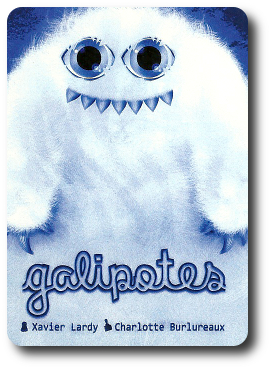
The Basics:
- For ages 6 and up (publisher suggests 8+)
- For 3 to 5 players
- Variable game length
Geek Skills:
- Counting & Math
- Logical & Critical Decision Making
- Pattern/Color Matching
- Strategy & Tactics
- Hand/Resource Management
Learning Curve:
- Child – Easy
- Adult – Easy
Theme & Narrative:
- A legendary creature has been spotted, but no one can agree on what it looks like
Endorsements:
- Gamer Geek mixed!
- Parent Geek approved!
- Child Geek approved!
Overview
The Galipotes is a legendary creature that roams the woods. Many have seen it – well – parts of it, at any rate. Glowing red eyes that might be yellow…possibly green. And teeth! Giant teeth that are red with blood or yellow with the stains of thousand devoured corpses! Then there are the claws, which reportedly change colors constantly. No one seems to agree on what the legendary creature looks like other than it’s big, furry, and downright frightening! Well, maybe not frightening…
Galipotes, a self-published game by Xavier Lardy via the Game Crafter, is comprised of 3 Start cards, 45 Galipote cards, and 6 Legend cards for a total of 54 cards. The illustrations on the cards are fairly minimalistic in design, but are colorful and stylized giving the game a unique look. The cards are made of standard card stock and durable. Not included with the game, but necessary to play, is a pen or pencil and some paper to record players’ scores.
So, There I Was…
To set up the game, first determine who the “Dealer” will be for the first round of play.
Second, the Dealer finds and places the 3 Start cards, face-up, in the middle of the playing area. The Start cards should be placed so they are in a column. The bottom-most Start card should have an image of a tree trunk base and what would appear to be claws, the middle Start card should have what appears to be a mouth, and the top-most Start card should have what appears to be eyes. When place correctly, the cards should reveal what looks like a giant “something” ineffectively hiding behind a tree.

Second, the Dealer finds and shuffles the 6 Legend cards. Place them in a single deck, face-up, above the top-most Start card (the one with eyes). This is the Legend draw deck.

Third, the Dealer shuffles the remaining 45 Galipote cards and deals 7 to each player, face-down. Place the remaining Galipote cards, face-down, at the other end of the column opposite of the Legend draw deck. This is the Galipote draw deck. Leave room next to the deck for a discard pile.
That’s it for game set up. The player sitting to the Dealer’s left goes first.
You Should Have Seen It!
A quick summary of how cards are played is in order. Galipotes is all about matching “elements”. An element has a type and color. Element types include claws, teeth, and eyes. Element colors include red, yellow, green, and “wild”, which is any color. Elements can be found on one or both sides of a card (teeth stretch from one side of the card to the other). No one Galipote card will have more than 1 element type. Some Galipote cards have “Fur”, which simply means there is no element on one side.
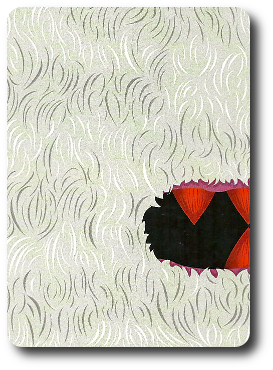
Example of a red teeth element card with fur
Galipote cards are played to the left and right of the Start cards in rows. Players can play to either side and the row does not end until a “Fur” card is placed at the end of the row. When playing cards, elements must match by type and color. Players can also place an element card upside down so the elements match, but the row card edges do not. The only other rule is that Galipote cards CANNOT overlay each other. This means that a row of Galipote cards that includes a card that is played upside down will stop any player from placing a Galipote card to the row above or below it if the cards would overlay.
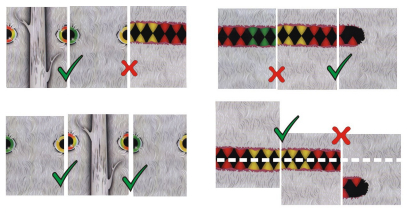
…It Must Have Been 100 Feet Tall!
Galipotes is played in turns and a game consists of a minimum of 3 hands. Players can play more than 3 hands if they like (I suggest 1 hand per player). A player will take several turns in a single hand. On a player’s turn, they will take 1 of 3 possible actions. The actions are summarized here.
Play One Non-Legend Card
Any Galipote card in the player’s hand that does not have a matching element type and color that is shown on the top-most Legend card is considered a “non-legend” Galipote card. Only 1 card of this Galipote card type can be played by the player using the card placement rules.
Play Up to Three Legend Cards
If a player does have Galipote cards that match the Legend card, they can play up to 3 of them.
Pass
A player is never forced to play cards on their turn. Sometimes the player doesn’t have any cards to play even if they wanted to. In either case, the player can or must pass. When the player passes, they must select 1 Galipote card from their hand and place it in the discard pile. The player then draws a new card from the top of the Galipotes draw deck.
This ends the player’s turn.
I Ran As Fast As I Could!
A player can place a maximum of one “Fur” Galipote card. If they do, they shout “FUR!”. A number of special actions now take place.
- The player who played the “Fur” Galipote card collects all the cards in that row, starting with the “Fur” Galipote card and ending with the first Galipote card played to the row. The Starter card and any Galipote cards on the opposite side of the Starter card remain.
- Each of the player’s opponents now get to vote. They can either vote to replace the current TOP Legend card (by placing it at the bottom and using the next Legend card on top), place the Legend card on the BOTTOM on top of the current Legend card, or do nothing. If the player’s opponents cannot come to a consensus, the player who placed the “Fur” Galipote card gets to decide.
I thought I was a Goner!
The player who plays the last card from their hand triggers the endgame. All the other players now have one final turn to play whatever cards remain in their hand. Each player still with cards should play as many as they can since the player who triggered the endgame will receive any cards NOT played by their opponents as bonus cards! Once everyone has had their last turn, scoring begins with each player going through their collected cards. Any cards NOT played are given to the player who triggered the endgame.
- 1 point for each different colored element combo (a maximum of 9 points possible for claws, eyes, and teeth)
- “Fur” edges count as 0 points
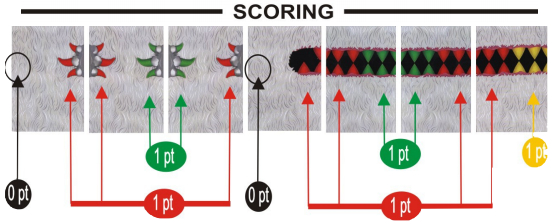
All the players record their scores and a new hand is played by reshuffling the Galipote cards. The Legend cards remain. After all the hands have been played, the player with the most points wins the game.
Game Variants
Hunting the Furries
In this game variant, if a player places a Galipote card with matching elements on either side (2 red claws, for example), the player can ask for all the “Fur” Galipote card with the same element type and color. For example, “I call for all Fur cards with a red claws”. Any player who has a Galipote card with that matching element and color MUST hand it over to the player who called for them.
Phantoms
In this game variant, 4 players organize themselves into teams of 2 and sit at the gaming table in alternating positions per team member. Three Galipote cards are drawn at random and placed aside during game set up. These cards should remain face-down above the Legend cards and hidden from all players. When a player would normally trigger the endgame for the hand, they instead pick up the 3 face-down Galipote cards. This player is now considered a “phantom” and can pass cards to their team member or draw new cards by discarding the cards they have. They DO NOT play to the rows attached to the Start cards. As soon as their team member who is still playing ends their hand, the endgame is triggered. Any cards the “phantom” player has are ignored during scoring. Points are scored as normal, with the team members adding their points together.
To learn more about Galipotes, visit the game’s web page on the Game Crafter.
Prediction
Here’s something interesting. “Galipote” (also spelled “gualipote”) is Taíno (the principal language of the Caribbean islands at the time of the Spanish Conquest) for “children of the devil”. Neat and not at all what you’d expect from looking at the illustration on the game’s cards. A Galipote is a nasty, evil creature that can take the shape of men, animals, and even inanimate objects like tress and stones. No wonder no one can get their story straight or agree on what the Galipote looks like. It can look like anything and everything, including your neighbor or a toaster.

I’m onto you, toaster….
The game itself is very casual and should appeal to both the Child Geeks and the Parent Geeks. Without playing the game, I cannot determine how well the Gamer Geeks will receive Galipotes. For example, Clubs surprised me with how many Gamer Geeks enjoyed it. Not enough to give the game the Gamer Geek full endorsement, but more than enough to suggest that serious game players should give it a try. Galipotes might just get a mixed endorsement, as well. There certainly appears to be a real need to time your card plays to get as many points as possible. That is usually enough to interest the Gamer Geeks.
Teaching Galipotes is best done by showing how elements are matched. Make sure you explain to your players how a card can be flipped upside down and how it impacts the row above or below it. This type of play can really hurt an opponent or the player, if not done right. Cards cannot be removed once played until the row is either completed with a “Fur” Galipote card or the hand ends. If a player makes a mistake, they will either lose their turn or inadvertently play a card that hurts their progress on the row. Note that Galipotes does not require anything more than pattern matching. Individuals who have difficulty distinguishing colors won’t have a problem playing the game since all they have to do is match the colors they see. Really, the only type of player who cannot play Galipotes are those who see only in black-and-white. This means you can teach your dog how to play.
After teaching the game to my 3 little geeks, I asked them their thoughts on Galipotes so far.
“A neat set collection and pattern matching game. The monster looks surprisingly cute.” ~Liam (age 9)
“Easy game, Dad. Let’s play!” ~Nyhus (age 6)
“I’m going to find the monster and get him!” ~ Ronan (age 4)
Yes, the “monster” really isn’t that horrific. Which is a very good thing. Still, those teeth look rather sharp. Let’s play Galipotes and see if we find a great card game or the fun remains elusive.
Final Word
The Child Geeks did very well with Galipotes and demonstrated smart plays. They even beat some older and more experienced players! Within their own peer group, the game was well understood and the game play was well-paced. The only issue that came up was some Child Geeks incorrectly identified cards they wanted to play. Technically, the rules suggest that a player loses their turn if they play a card incorrectly to the row. We ignored this rule completely and just let the Child Geek (or any geek) keep trying. According to one Child Geek, “This is a fun card game because you are trying to catch a monster!” An interesting observation. The game itself is all about set collecting and pattern matching, but the Child Geeks see the game as a monster hunt. I cannot disagree. When all the games were over, all the Child Geeks voted to approve Galipotes.
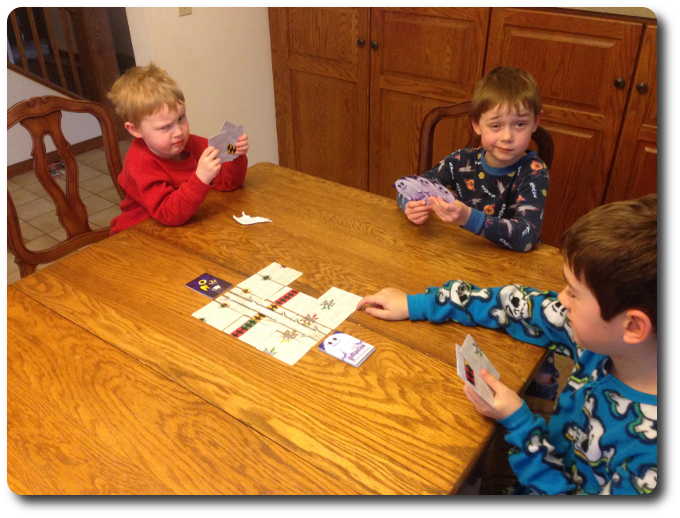
A quick snapshot of my 3 little geeks playing the game – the two youngest gave me questionable looks…
The Parent Geeks thought Galipotes was a wonderful game for both their families and with their peers. They found the game play to be intuitive and some of the card plays maddeningly complicated. According to one Parent Geeks, “My biggest headache with this game is suffering through hindsight! If I only played this card instead of that card, I could have won!” Despite a tremendous amount of hindsight stress experienced by some players, the game was very well received. All the Parent Geeks voted to approve Galipotes since it was found to be easy to learn and a lot of fun to play.
The Gamer Geeks had mixed feelings about Galipotes. According to one Gamer Geek, “I like what this game is about and how it’s played, but I don’t think it’s a Gamer Geek’s game. I’d play it with friends and family, though.” Another Gamer Geek disagreed stating, “I would play this with anyone. You have to think about what cards you want to play, how to collect rows, and attempt to remember what cards your opponents have won. That, to me, is more than enough to give it my full endorsement!” When all the games were over, the Gamer Geeks remained mixed. They all found the game to be a fun one, but they couldn’t agree if the level of skill necessary to play the game met their elitist requirements.
I really like Galipotes and continue to find it to be an enjoyable game to play with whomever I am lucky enough to sit down at the table with. The game play is very straightforward, but what cards you need to play is most certainly up to debate. The overall goal for all players is to collect as many cards as possible, since the more cards you collect means fewer cards for your opponents to score. But you only get so many points. This means that a player might sometimes be torn between collecting a row they know they won’t score or continuing to work on a row that they know they can earn big points on IF they are the one to collect it. Having a row you worked hard on taken from you is a common occurrence and quickly teaches all players that smart card plays and timing is all important. Simply excellent.
Do take a look at Galipotes, especially if you are a fan of Card games that can be played with a diverse group of players.
This game was given to Father Geek as a review copy. Father Geek was not paid, bribed, wined, dined, or threatened in vain hopes of influencing this review. Such is the statuesque and legendary integrity of Father Geek.
Discover more from Father Geek
Subscribe to get the latest posts sent to your email.



Pingback: Today in Board Games Issue #166 - Club Fantasci - Today in Board Games
Pingback: In Review: Father Geek’s Monthly Newsletter (May 2014) » Father Geek
Pingback: In Review: Father Geek’s Monthly Newsletter (June 2014) » Father Geek
Pingback: Barbecue Game Review - Father Geek